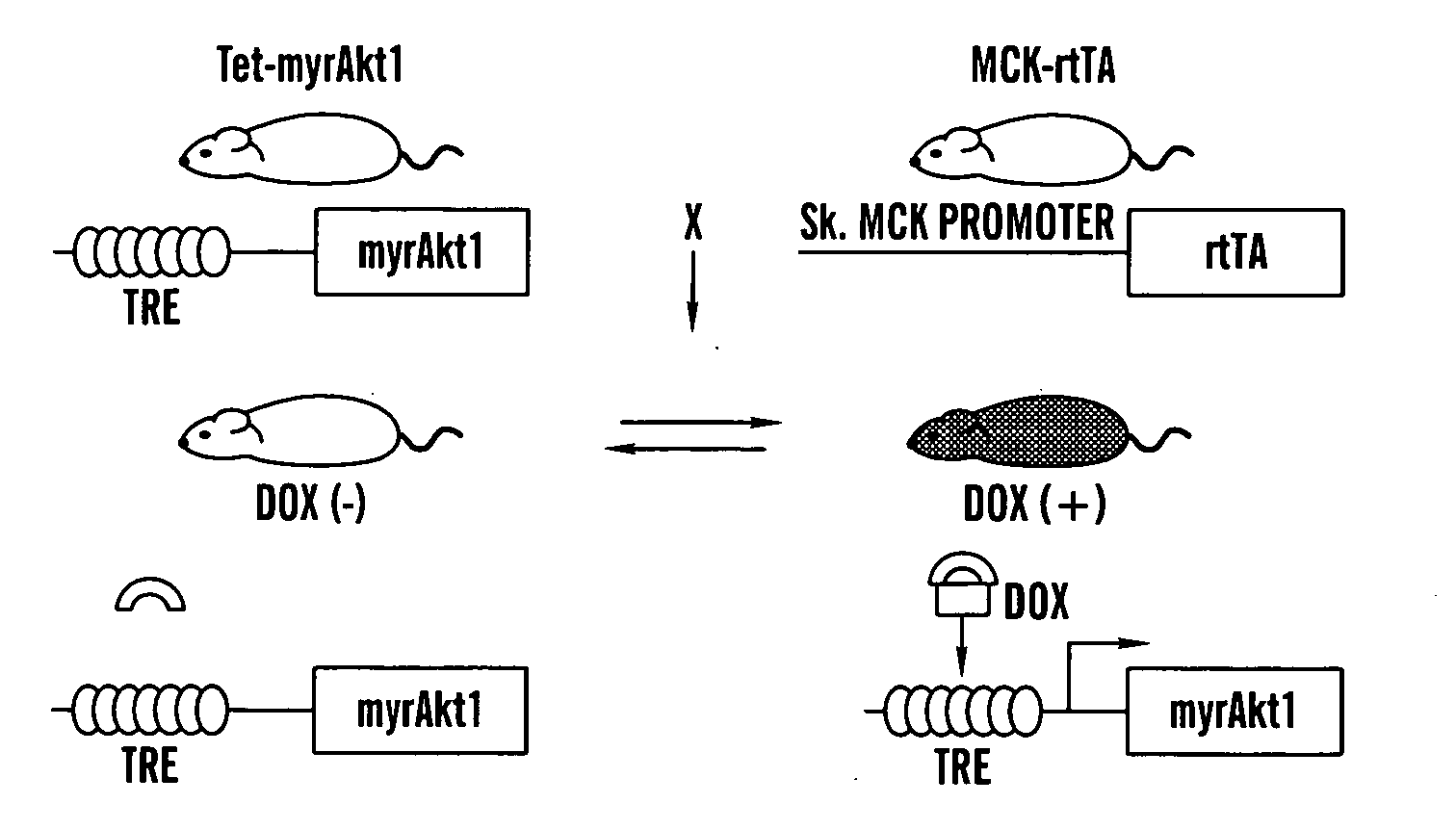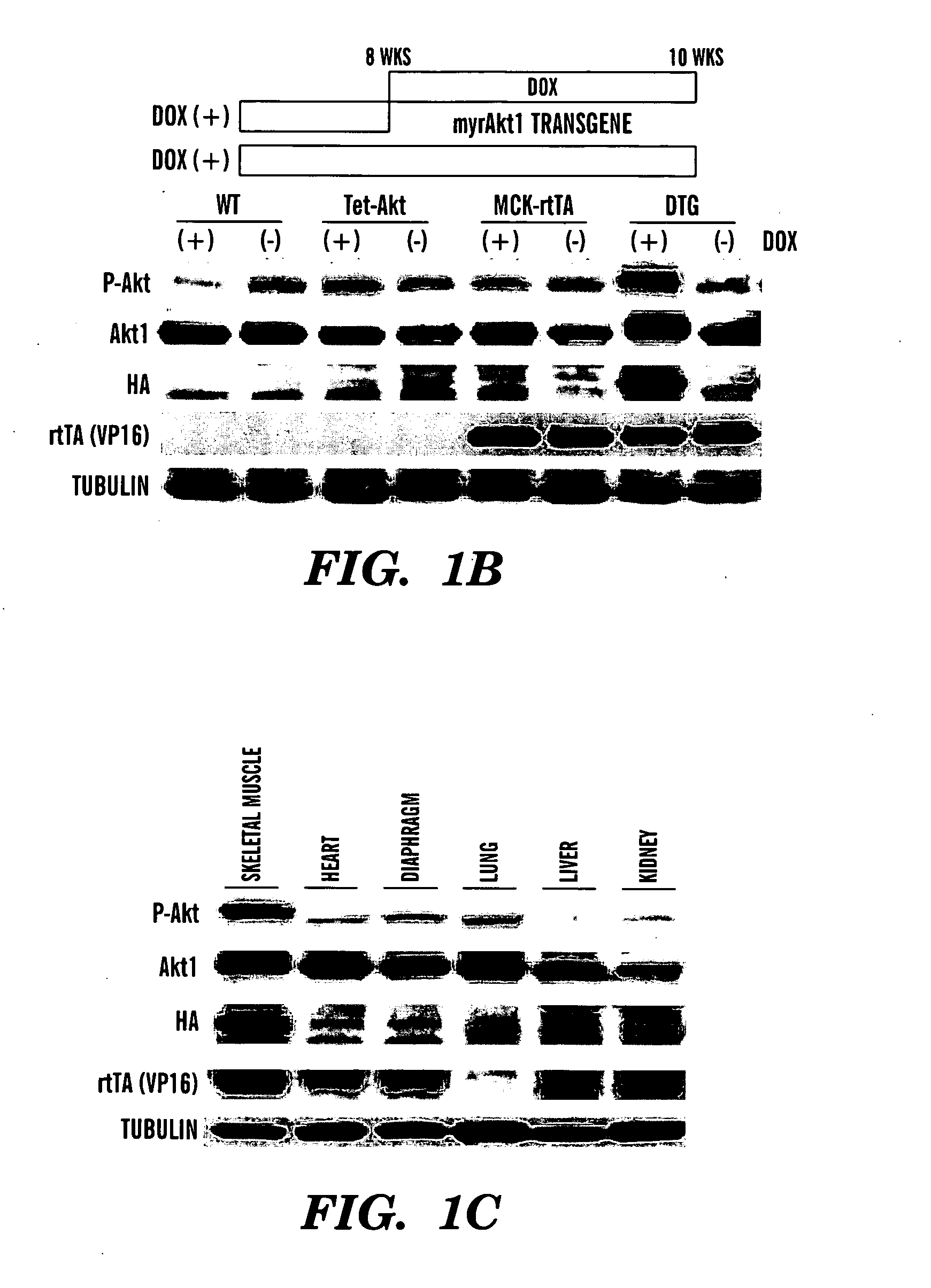Methods to identify factors associated with muscle growth and uses thereof
a technology of factors and muscle growth, applied in the direction of peptide/protein ingredients, drug compositions, metabolic disorders, etc., can solve the problems of poorly understood hormone regulatory mechanisms by which skeletal muscle controls lipolysis and fatty acid mobilization and uptake by muscle, and the molecules secreted by growing muscle that orchestrate these processes are largely unknown
- Summary
- Abstract
- Description
- Claims
- Application Information
AI Technical Summary
Benefits of technology
Problems solved by technology
Method used
Image
Examples
example 1
Skeletal Muscle-Specific Akt1 Transgenic Mice
[0357]GENERATION OF SKELETAL MUSCLE-SPECIFIC INDUCIBLE AKT1 TG MICE: Two lines of TG mice (Tet-myrAkt1 and MCK-rtTA) were used to generate skeletal muscle-specific conditional Akt1 TG mice (FIG. 1A). Tet-myrAkt1 TG line harbours an active form of Akt1 (myrAkt1) transgene under the control of tetracycline responsive element (TRE) (Shiojima et al., 2005), and MCK-rtTA TG line expresses reverse tetracycline transactivator (rtTA: a fusion protein of TRE and VP16 transactivation domain) in the skeletal muscle driven by mutated MCK promoter (Grill et al., 2003). Treatment of double transgenic (DTG) mice harboring both of two transgenes with doxycycline (DOX) results in myrAkt1 transgene expression because DOX associates with rtTA enable to binding to TRE. On the other hand, withdrawal of DOX inhibited rtTA to bind to TRE and repression of myrAkt1 expression in the skeletal muscle. Mating of Tet-myrAkt1 mice and MCK-rtTA mice resulted in the gen...
example 2
Detailed Characterization of Activation Akt1in Skeletal Muscle
[0368]Transgenic mice with inducible expression of Akt in muscle were further characterized, as shown in FIGS. 9-12. When expression of Akt was induced by administration of DOX(DTG) to the drinking water hypertrophy of Type IIb muscle fibers, typically glyolytic / fast twitch fibers is seen compared to wild type mice, and less Type I and Type IIa fibers occur in DOX treated Akt mice compared to control.
[0369]Transgenic Akt mice fed DOX fed high fat and high sugar (HF / HS) also have increased lipid peroxidation in the liver but not muscle compared to control mice fed HF / HS diet, as detected by quantitative gene expression analysis if a number of mRNAs associated with fatty acid oxidation and mitochondrial biogenesis (FIG. 10A) and increase in total fatty acid β-oxidation of palmitic acid (FIG. 10C), and also morpholological analysis of liver using oil red-O stain (FIGS. 7A and 10B). In Akt transgenic mice fed HF / HS diet, PG...
example 3
[0371]INDUCEBLE EXPRESSION OF AKT1 IN VITRO: Transduction of cells in vitro or tissues in vivo with Akt1, Akt2 or Akt3 (constitutively-active or dominant-negative forms) should lead to similar changes in transcript levels because we have shown previously that Akt2 (Fujio Y. et al. 2001 Cell Death Duff 8:1207-1212), and Akt3 (Y. Taniyama 2005 J Mol Cell Cardiol 38:375-385) share function properties with Akt1.
[0372]To examine if activation of Akt in skeletal cells in vitro leads to similar changes in gene expression, a myogenic cell line, C2C12 cells, was transduced with an adenovirus expressing Akt1 (Adv-myrAkt). Comparison of gene expression of Adv-myrAkt cells transfected cells 1 day after with skeletal muscle cells of induced expression of Akt1 in skeletal muscle in mice have a highly similar gene expression profile, indicating skeletal muscle cells expressing Akt1 cultured in vitro are effective tools for studying muscle secreted proteins (MSP) or myokines
[0373]As shown in FIG. 8...
PUM
| Property | Measurement | Unit |
|---|---|---|
| time | aaaaa | aaaaa |
| time | aaaaa | aaaaa |
| time | aaaaa | aaaaa |
Abstract
Description
Claims
Application Information
 Login to View More
Login to View More - R&D
- Intellectual Property
- Life Sciences
- Materials
- Tech Scout
- Unparalleled Data Quality
- Higher Quality Content
- 60% Fewer Hallucinations
Browse by: Latest US Patents, China's latest patents, Technical Efficacy Thesaurus, Application Domain, Technology Topic, Popular Technical Reports.
© 2025 PatSnap. All rights reserved.Legal|Privacy policy|Modern Slavery Act Transparency Statement|Sitemap|About US| Contact US: help@patsnap.com



